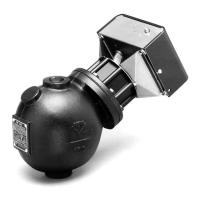BLOW DOWN PROCEDURE:
Blow down the low water cut-off when the water level
is at its normal level (pump/valve off) and the burner
is on.
• Open upper valve (#1).
• Slowly open lower valve (#2).
• With both valves open the water level will drop in
the sight glass.
• When the water falls below the level of the middle
probe, the pump or valve should turn on.
• When the water falls below the level of the bottom
probe, the burner should turn off. NOTE: The Red
LED will turn on to indicate low water condition.
• Slowly close the lower valve (#2).
• The water level should begin to rise and the burner
should turn on (Red LED turns off) when the level is
at the middle probe. The pump or valve should turn
off when the water level rises above the top probe.
NOTE: On manual reset models, the red reset button
will need to be pressed after the water level is
restored to the level of the middle probe before the
burner will operate.
• Close the upper valve (#1).
To prevent serious personal injury from steam
pipe blow down, connect a drain pipe to the
control opening to avoid exposure to steam
discharge.
Failure to follow this caution could cause
personal injury.
CAUTION
MAINTENANCE
SCHEDULE:
Blow down control as follows when boiler is in
operation.
• Daily if operating pressure is above 15 psi.
• Weekly if operating pressure is below 15 psi.
Disassemble and inspect annually.
•
Remove sediment or debris from float chamber.
• Inspect and clean probes. Use a non-abrasive
cloth to clean probes and water-side of flange.
Replace head mechanism every 5 years.
More frequent replacement may be required when
severe conditions exist such as rapid switch
cycling, surging water levels and use of water
treatment chemicals.
Replacement parts are available from your
local authorized McDonnell & Miller
Distributor. The use of parts or components other
than those manufactured by McDonnell & Miller
will void all warranties and may affect the units
compliance with listing or regulating agencies.
WARNING
DO NOT REMOVE PROBES FROM FLANGE. Replace probe
flange assembly if probe Teflon
®
insulation is broken, torn
or frayed.
NOTE
The probes may need to be inspected and cleaned more
frequently on systems with high raw water make-up.This
includes systems with no condensate return or untreated
boiler water.
NOTE
More frequent blow-down may be necessary due to
dirty boiler water and/or local codes.

